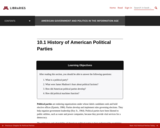
This chapter of a textbook explains political parties and their origins.
- Subject:
- History
- Material Type:
- Reading
- Textbook
- Provider:
- University of Minnesota Libraries
- Author:
- University of Minnesota
- Date Added:
- 06/02/2022

This chapter of a textbook explains political parties and their origins.

Propaganda is central to any war effort. In the early 20th century, the persuasion to head into battle came, in part, from art: The government recruited artists and illustrators to create propaganda materials. In a new exhibit, the Museum of the City of New York is showing how New York City-based artists and creatives working for the federal government’s Division of Pictorial Publicity helped sell World War I to the public.

This resource from the National Constitution Center includes an introduction, big questions, recorded class sessions, briefing documents, slide decks, and worksheets about the fourteenth amendment of the United States Constitutuion.
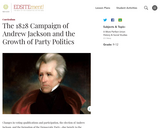
Changes in voting qualifications and participation, the election of Andrew Jackson, and the formation of the Democratic Party"”due largely to the organizational skills of Martin Van Buren"”all contributed to making the election of 1828 and Jackson's presidency a watershed in the evolution of the American political system.

In the 1920s, assembly line production and easy credit made it possible for ordinary Americans to purchase many new consumer goods.

This resource from the National Constitution Center includes an introduction, big questions, recorded class sessions, briefing documents, slide decks, and worksheets about the nineteenth amendment of the United States Constitutuion.

This site has collected and currated 20 photos of Utah that were taken as part of the New Deal photography project. These photos can be used at any level and in a variety of ways in the classroom.
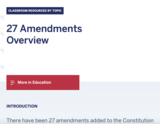
This resource from the National Constitution Center includes an introduction, big questions, recorded class sessions, briefing documents, slide decks, and worksheets about the 27 amendments of the United States Constitutuion.
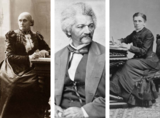
Through a whole-class read-aloud of the historical fiction picture book (text provided), Friends for Freedom: The Story of Susan B. Anthony and Frederick Douglass, and two historical articles, students will compare activists Susan B. Anthony, Frederick Douglass, and Utahn Emmeline B. Wells. Students will examine the statue that depicts the friendship of Anthony and Douglass and complete one of the following: a) a compare/contrast essay, b) a sketch of a statue to represent the friendship between Anthony and Wells, or c) a dialogue between Anthony, Douglass, and Wells. The purpose of this lesson is to not only learn about these advocates for change, but to develop the skills of civil and respectful dialogue, particularly with those with whom we may disagree.
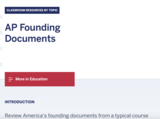
Review America’s founding documents from a typical course of study for an AP Government class and understand these essential documents better—including their fundamental ideas and the major principles underlying the U.S. Constitution. Primary sources include the Declaration of Independence, the Articles of the Confederation, the Constitution (including the Bill of Rights), The Federalist Papers (#51, #70, #78), Brutus #1, and Martin Luther King Jr.’s Letter from the Birmingham City Jail.

This resource is an article about abolitionists and the U.S. Constitution. Access to this resource requires a free educator login.
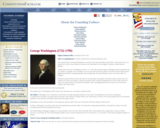
Read information about the "Founding Fathers" of the United States of America, including George Washington, James Madison, Thomas Jefferson, John Adams, Benjamin Franklin, Alexander Hamilton, George Mason, Gouverneur Morris, Roger Sherman, James Wilson, and Edmund Randolph.

On September 17, 1787, the Constitutional Convention came to a close in the Assembly Room of Independence Hall in Philadelphia, Pennsylvania. There were seventy individuals chosen to attend the meetings with the initial purpose of amending the Articles of Confederation.
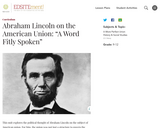
By examining Lincoln's three most famous speeches the Gettysburg Address and the First and Second Inaugural Addresses in addition to a little known fragment on the Constitution, union, and liberty, students trace what these documents say regarding the significance of union to the prospects for American self-government.

Indigenous peoples were able to gather their most basic needs for shelter using the items around them. Before lumber became the go to, adobe was a staple building material for the southwest and other Indigenous communities. But what makes this humble brick so simple yet sturdy and sustainable?
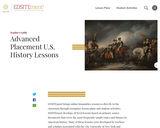
EDSITEment brings online humanities resources directly to the classroom through exemplary lesson plans and student activities. EDSITEment develops AP level lessons based on elementary source documents that cover the most frequently taught topics and themes in American history. Many of these lessons were developed by teachers and scholars associated with the City University of New York and Ashland University.
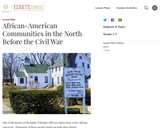
One of the heroes of the Battle of Bunker Hill was Salem Poor, an African American. Black people fought on both sides during the American Revolution. Census data also reveal that there were slaves and free Blacks living in the North in 1790 and after. What do we know about African-American communities in the North in the years after the American Revolution?

In this media gallery, you will find a series of videos from The African Americans: Many Rivers to Cross that examines the major movements and turning points in African American history from 1968 to the present, including the Black Panthers and the Black Power movement, Afrocentricity in culture, the rise of the black middle class, the development of hip hop culture, the effects of the War on Drugs, and the election of Barack Obama. As you view the videos, consider the legacy of the civil rights movement, the tensions that emerged from the progress made, and how they reshaped the African American experience.
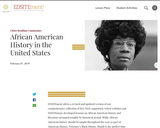
In this special revised and updated feature for Black History Month, teachers, parents, and students will find a collection of NEH-supported websites and EDSITEment-developed lessons that tell the four-hundred-year old story of African Americans from slavery through freedom and citizenship to the presidency.
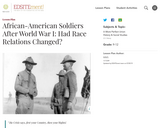
In this lesson, students view archival photographs, combine their efforts to comb through a database of more than 2,000 archival newspaper accounts about race relations in the United States, and read newspaper articles written from different points of view about post-war riots in Chicago.